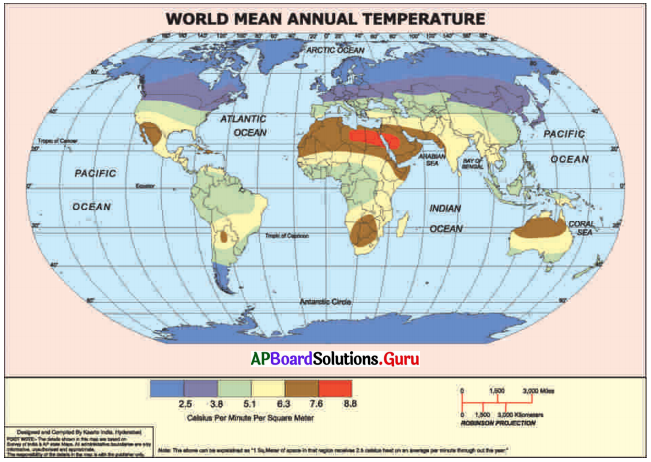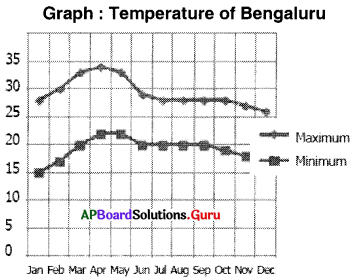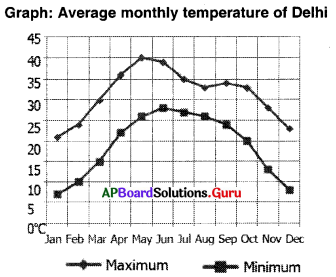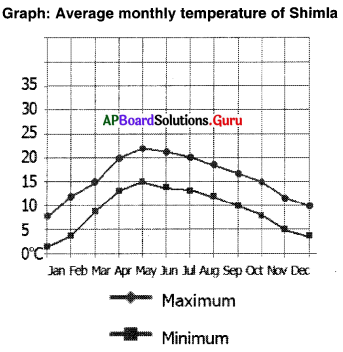Practice the AP 8th Class Social Bits with Answers Chapter 2 Energy from the Sun on a regular basis so that you can attempt exams with utmost confidence.
AP State Syllabus 8th Class Social Bits 2nd Lesson Energy from the Sun with Answers
Choose the correct answer.
Question 1.
Temperature difference between places also causes winds and
A) Rains
B) Energy
C) Angle of incidence
D) Global warming
Answer:
A) Rains
Question 2.
The solar radiation received on the surface of the Earth is called
A) Radiation
B) Insolation
C) Reflection
D) Angle of incidence
Answer:
B) Insolation
![]()
Question 3.
It will get more warmer on the …………… than the regions near the poles.
A) Arctic circle
B) Antarctic circle
C) Equator
D) Tropic of Cancer
Answer:
C) Equator
Question 4.
It Is safer and advisable to use thermometer that has a scale of …………..
A) 10°C -110°C
B) 10°C to 90°C
C) 10°C -100°C
D) 10°C – 120°C
Answer:
A) 10°C -110°C
Question 5.
………… is far away from the sea.
A) Kolkata
B) Panaji
C) Hyderabad
D) Kanyakumari
Answer:
A) Kolkata
Question 6.
Indonesia is in this region of
A) Arctic
B) Antarctic
C) Temperate
D) Equatorial
Answer:
D) Equatorial
Question 7.
……………. decreases with elevation.
A) Temperature
B) Insolation
C) Radiation
D) Reflection
Answer:
A) Temperature
![]()
Question 8.
…………… cannot be seen but can be felt.
A) Oceans
B) Continents
C) Mountains
D) The diversity in temperature
Answer:
D) The diversity in temperature
Question 9.
The difference between the temperatures of two places influence these
A) winds
B) rains
C) both A & B
D) none
Answer:
C) both A & B
Question 10.
Trees and animals live by depending on these.
A) heat
B) water
C) both A & B
D) none
Answer:
C) both A & B
Question 11.
The energy which is constantly emitted by the Sun is known as
A) Solar radiation
B) Solar insolation
C) Solar ray
D) Solar energy
Answer:
D) Solar energy
Question 12.
The energy comes from the Sun in this form.
A) Sun’s rays
B) Sunlines
C) Solar radiation
D) All the above
Answer:
A) Sun’s rays
![]()
Question 13.
The energy comes from the Sun in this form.
A) Ultraviolet rays
B) Radio waves
C) X – rays
D) All the above
Answer:
D) All the above
Question 14.
…………… of the solar energy is reflected back by the Earth’s atmosphere.
A) 1/2
B) 1/3
C) 1/4
D) 1/5
Answer:
B) 1/3
Question 15.
Some amount of solar rays are also absorbed or reflected away by
A) Clouds
B) Smoke
C) Dust
D) All the above
Answer:
D) All the above
Question 16.
The equatorial region is hot when compared to the poles.
A) The same amount of solar energy falls on a larger area on the equator and on a smaller area as we move north and south of it.
B) The same amount of solar energy falls on a smaller area on the equator and on a larger area as we move north and south of it.
C) Both A & B
D) None
Answer:
B) The same amount of solar energy falls on a smaller area on the equator and on a larger area as we move north and south of it.
![]()
Question 17.
The angle at which the sunrays fall on the earth’s surface.
A) Better angle
B) Angle of incidence
C) Increasing angle
D) None
Answer:
B) Angle of incidence
Question 18.
The angle of incidence increases in the north during the months of
A) May – June
B) November – December
C) September – October
D) June – July
Answer:
B) November – December
Question 19.
The atmosphere or the air around US is heated by the sunrays in this way.
A) heated directly
B) not heated directly
C) mixes in the air
D) all the above
Answer:
B) not heated directly
Question 20.
The gas that objects the radiation of the earth.
A) O2
B) Organ
C) CO2
D) All the above
Answer:
C) CO2
Question 21.
The instrument that measure atmospheric temperature.
A) Barometre
B) Celsius Thermometre
C) Anemometre
D) All the above
Answer:
B) Celsius Thermometre
Question 22.
The highest temperature that is recorded in Azizia in Libya in July 1992.
A) 56°C
B) 57°C
C) 57.8°C
D) 68°C
Answer:
C) 57.8°C
![]()
Question 23.
The lowest temperature that was recorded in Vostok in Antarctica in July 1983.
A) – 68°C
B) – 89.2°C
C) – 90°C
D) – 90.2°C
Answer:
B) – 89.2°C
Question 24.
The lowest temperature that is less than zero.
A) – 273°C
B) – 274°C
C) -273.16°C
D) – 264°C
Answer:
C) -273.16°C
Question 25.
The highest temperature in Ananthapuram is recorded in this month.
A) April
B) May
C) July
D) Both A & B
Answer:
D) Both A & B
Question 26.
The lowest temperature in Ananthapuram is recorded in this month.
A) September
B) October
C) November
D) December
Answer:
D) December
Question 27.
The highest temperature is recorded in Visakhapatnam in this month.
A) May
B) January
C) September
D) March
Answer:
A) May
![]()
Question 28.
The temperatures when moving to high altitudes.
A) decrease
B) increase
C) no change
D) none
Answer:
A) decrease
Question 29.
For ascent of 1000 mtrs. from the sea level the temperature.
A) increases 6°C
B) decreases 6°C
C) no change
D) decreases 4°C
Answer:
B) decreases 6°C
Question 30.
The temperature inversion is recorded in
A) Mountain Valleys
B) The regions where the daytime is less and night time is more with low earth’s radiation
C) Near the earth during winters
D) All the above
Answer:
D) All the above
Question 31.
The temperature in the regions near the equator.
A) more
B) low
C) no change
D) change is present
Answer:
A) more
Question 32.
The regions in India that have average temperature is 30°C in January in India.
A) Many are there
B) No places are there
C) Both A & B
D) None
Answer:
A) Many are there
Question 33.
VOSTOK is a station in
A) Arctic region
B) Antarctica
C) Australia
D) America
Answer:
B) Antarctica
Question 34.
If the insolation received at the equator (0°) is 100 units, then the number of units at 45° (Northern Japan)
A) 50
B) 40
C) 75
D) 100
Answer:
C) 75
![]()
Question 35.
If the insolaiton received at the equator (0°) is 100 units, then the number of units at 661/2° (Arctic circle)
A) 40
B) 50
C) 25
D) 45
Answer:
B) 50
Question 36.
The lowest temperature in Visakhapatnam is recorded in this month.
A) January
B) December
C) March
D) May
Answer:
A) January
Question 37.
The energy radiated by the Sun is ……………… throughout the year and year after year.
A) more or less constant with very little variation
B) different
C) increases
D) decreases
Answer:
A) more or less constant with very little variation
Question 38.
Even the rays that reach the ground do not heat the Earth’s surface uniformly.
A) because the earth’s surface is flat
B) because the earth’s surface is curved.
C) because the earth’s surface is up and down
D) all the above
Answer:
B) because the earth’s surface is curved.
Question 39.
If the Earth radiates back more heat than it receives, then it changes like this.
A) cool
B) warm
C) temperate
D) all the above
Answer:
A) cool
Question 40.
The reason for increase of CO2
A) the increased usage of petrol & diesel, etc.
B) cutting forests
C) both A & B
D) none
Answer:
C) both A & B
![]()
Question 41.
The moderating climate influence is on this region.
A) Chennai
B) Visakhapatnam
C) Panaji
D) All the above
Answer:
D) All the above
Question 42.
The moderating climate influence is hot on this region.
A) Delhi
B) Jaipur
C) Simla
D) All the above
Answer:
D) All the above
Observe the given map and answer the following questions.

Question 43.
What is the line to the south of equator?
A) Tropic of Cancer
B) Pacific Ocean
C) Tropic of Capricorn
D) None of the above
Answer:
C) Tropic of Capricorn
![]()
Question 44.
What is the line to the north of equator?
A) Tropic of Cancer
B) Arctic Ocean
C) Tropic of Capricorn
D) None of the above
Answer:
A) Tropic of Cancer
Question 45.
This is …………. projection.
A) Rachalson
B) Johnson
C) Jackson
D) Robinson
Answer:
D) Robinson
Question 46.
The continents that are near to the equator
A) South America
B) Africa
C) Asia
D) All the above
Answer:
D) All the above
Question 47.
The given map is about
A) World mean temperature
B) World mean annual temperature
C) India’s mean temperature
D) India’s mean annual temperature
Answer:
B) World mean annual temperature
![]()
Look at the graph of Minimum- Maximum temperature given below and answer the questions.

Question 48.
The average highest temperature in July
A) 28°C
B) 35°C
C) 15°C
D) 40°C
Answer:
A) 28°C
Question 49.
There is a bigger difference between day and night temperatures in the month of
A) November
B) May
C) December
D) January
Answer:
B) May
Question 50.
The minimum temperature in June
A) 28°C
B) 26°C
C) 20°C
D) 15°C
Answer:
C) 20°C
Question 51.
The maximum temperature in December
A) 26°C
B) 18°C
C) 20°C
D) 30°C
Answer:
A) 26°C
Question 52.
This graph shows
A) temperature of Amaravathi
B) temperature of Lucknow
C) temperature of Tamil Nadu
D) temperature of Bengaluru
Answer:
D) temperature of Bengaluru
![]()
Observe the following graphs and answer the questions.


Question 53.
The month that receives the highest maximum temperature in Shimla
A) February
B) October
C) August
D) May
Answer:
D) May
Question 54.
The month that receives the lowest minimum temperature in Delhi
A) January
B) November
C) September
D) June
Answer:
A) January
Question 55.
In September, the average maximum temperature in Shimla is 17°C, while in Delhi it is
A) 30°C
B) 26°C
C) 34°C
D) 15°C
Answer:
C) 34°C
Question 56.
The highest maximum temperature in Delhi in the month of May is
A) 28°C
B) 22°C
C) 12°C
D) 40°C
Answer:
D) 40°C
![]()
Question 57.
Shimla has temperature in September.
A) 10°C
B) 5°C
C) 20°C
D) 2°C
Answer:
A) 10°C
Question 58.
Some gases like ……………… prevent radiation of heat from the earth.
A) Oxygen
B) Nitrogen
C) Hydrogen
D) Carbon-di-oxide
Answer:
D) Carbon-di-oxide
Question 59.
…………… will take time to heat and cool.
A) Land
B) Oceans
C) Mountains
D) Valleys
Answer:
B) Oceans
Question 60.
The hot regions throughout the year.
A) Temperate regions
B) Polar regions
C) Equatorial regions
D) All the above
Answer:
C) Equatorial regions
Question 61.
…………… influence lives very much.
A) Temperature
B) Rainfall
C) Both A & B
D) None
Answer:
C) Both A & B
![]()
Question 62.
The main source of energy on the earth.
A) Jupiter
B) Mars
C) Moon
D) Sun
Answer:
D) Sun
Question 63.
The Global warming means
A) The earth’s radiation decreases as CO2 increases.
B) The earth’s radiation increases as CO2 decreases.
C) Both A & B
D) The CO2 is constant and the earth’s radiation is also constant
Answer:
A) The earth’s radiation decreases as CO2 increases.